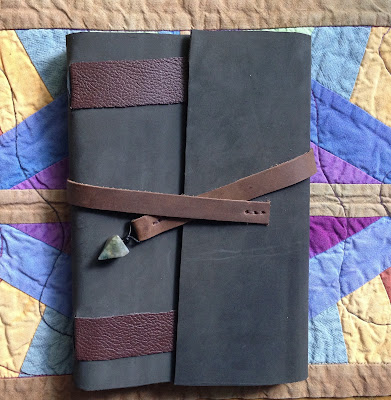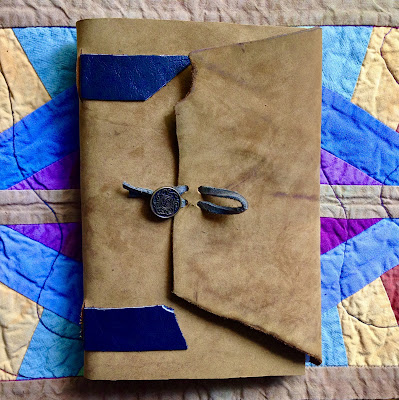Here are my latest Handbound Leather journals for sale.
Leather Journals wrapped with strap with a stone attached.
1. A rich gold brown colour leather with dark blue straps around the spine, and the wrapping strap is a quite dark green colour. The stone is actually a small shell.
Leather Journals wrapped with a strap with a charm attached
7. A navy blue colour leather with wrapping strap in a dark brown colour. The flower charm is a tarnished silver finish.
8. A navy blue colour leather with wrapping strap in a dark brown colour. The key charm is a brass finish. SOLD
9. A rich gold brown colour leather with brown straps around the spine, and the wrapping strap is a quite dark green colour. The bird charm is a tarnished silver finish.
11. A dark green colour leather with deep red straps around the spine, and the wrapping strap is a rich gold brown colour. Has a silver peace sign charm with a tarnish finish. SOLD
12. A dark green colour leather with light blue straps around the spine, and the wrapping strap is a rich gold brown colour. Has a silver key charm with a tarnish finish.
13. A rich gold brown colour leather with deep red straps around the spine, and the wrapping strap is a quite dark green colour with a tarnish finish silver horse charm. SOLD
14. A deep medium brown colour leather with dark blue straps around the spine, and the wrapping strap is of the same leather with a shiny silver coloured leaf charm.
Leather Journals with a leather sliding button closure
15. A rich gold brown colour leather with dark blue straps around the spine, and a sliding strap metal button closure.
16. A deep medium brown colour leather with a sliding strap and gold coloured metal button closure.
17. A rich gold brown colour leather with a sliding button closure. Button is repurposed, black with a coat of arms.
18. A deep medium brown colour leather with a sliding strap metal button closure. Repurposed gold coloured button, with shiny pearl-look centres. SOLD
20. A rich gold brown colour leather with sliding closures - two brushed gold-coloured buttons. SOLD
21. A dark green colour leather with sliding closures—two repurposed shiny gold-coloured button.
Leather Journals with cotton cord sliding button closure
22. A dark green colour leather with dark blue straps around the spine, and a repurposed metal button with a sliding cotton cord and small gemstone. SOLD
23. A deep medium brown colour leather with deep red straps around the spine, and a repurposed metal button with a sliding cotton cord and small gemstone. SOLD
26. A rich gold brown colour leather with brown straps around the spine, and a cameo button with a sliding cotton cord and small gemstone.
If you are interested in purchasing any of these journals, please contact me by leaving a comment below. They are 8.75 x 6". The pages are made from acid-free paper, so it is suitable for sketching, journalling, and even mounting photographs. Cost per journal is $65.00 Canadian plus shipping. I accept etransfer. You can also contact me on instagram whatthesehandsmake
Smaller Leather Journals
I have a few journals that are a bit smaller, but with the same acid-free paper. Each book is 6" wide by 7.25" high. Price of each is $55.00 Canadian plus shipping.
29. Red brown coloured leather cover with wrap strap closure and labradorite gemstone bookmark.
30. Red brown coloured leather cover with wrap strap closure and labradorite gemstone bookmark. SOLD
31. Shiny purple leather cover with green strap button closure and amazonite gemstone bookmark. SOLD



































